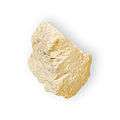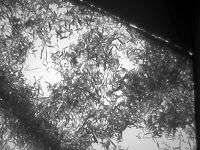Halloysite
| Halloysite | |
|---|---|
|
Trammission electronic microscope (TEM) image of halloysite nanotubules (unknown scale) | |
| General | |
| Category |
Phyllosilicates Kaolinite-serpentine group |
| Formula (repeating unit) | Al2Si2O5(OH)4 |
| Strunz classification | 9.ED.10 |
| Crystal system | Monoclinic |
| Crystal class |
Domatic (m) H-M symbol: (m) |
| Space group | Cc |
| Unit cell |
a = 5.14, b = 8.9 c = 7.214 [Å]; β = 99.7°; Z = 1 |
| Identification | |
| Color | White; grey, green, blue, yellow, red from included impurities. |
| Crystal habit | Spherical clusters, massive |
| Cleavage | Probable on {001} |
| Fracture | Conchoidal |
| Mohs scale hardness | 2 - 2.5 |
| Luster | Pearly, waxy, or dull |
| Diaphaneity | Semitransparent |
| Specific gravity | 2 - 2.65 |
| Optical properties | Biaxial |
| Refractive index | nα = 1.553 - 1.565 nβ = 1.559 - 1.569 nγ = 1.560 - 1.570 |
| Birefringence | δ = 0.007 |
| References | [1][2][3] |
Halloysite is a 1:1 aluminosilicate clay mineral with the empirical formula Al2Si2O5(OH)4. Its main constituents are aluminium (20.90%), silicon (21.76%) and hydrogen (1.56%). Halloysite typically forms by hydrothermal alteration of alumino-silicate minerals.[4] It can occur intermixed with dickite, kaolinite, montmorillonite and other clay minerals. X-ray diffraction studies are required for positive identification. It was first described in 1826 and named after the Belgian geologist Omalius d'Halloy.
Structure
Two common forms are found, when hydrated the clay exhibits a 1 nm spacing of the layers and when dehydrated (meta-halloysite) the spacing is 0.7 nm. Halloysite naturally occurs as small cylinders which average 30 nm in diameter with lengths between 0.5 and 10 μm.[5] The cation exchange capacity depends on the amount of hydration, as 2H2O has 5–10 m.e./100g, while 4H2O has 40–50 m.e./100g.[6] "Endellite" is the alternative name for the 4H2O structure.[6]
Occurrence
The formation of halloysite is due to hydrothermal alteration, and it is often found near carbonate rocks. For example, halloysite samples found in Wagon Wheel Gap, Colorado, United States are suspected to be the weathering product of rhyolite by downward moving waters.[4] In general the formation of clay minerals is highly favoured in tropical and sub-tropical climates due to the immense amounts of water flow. Halloysite has also been found overlaying basaltic rock, showing no gradual changes from rock to mineral formation.[7] Halloysite occurs primarily in recently exposed volcanic-derived soils, but it also forms from primary minerals in tropical soils or pre-glacially weathered materials.[8] Igneous rocks, especially glassy basaltic rocks are more susceptible to weathering and alteration forming halloysite.
Often as is the case with halloysite found in Juab County, Utah, United States the clay is found in close association with goethite and limonite and often interspersed with alunite. Feldspars are also subject to decomposition by water saturated with carbon dioxide. When feldspar occurs near the surface of lava flows, the CO2 concentration is high, and reaction rates are rapid. With increasing depth, the leaching solutions become saturated with silica, aluminium, sodium, and calcium. Once the solutions are depleted of CO2 they precipitate as secondary minerals. The decomposition is dependent on the flow of water. In the case that halloysite is formed from plagioclase it will not pass through intermediate stages.[4]
One of the largest halloysite deposits in the world is the "Dunino" deposit near Legnica in Poland. It has reserves estimated at 10 million tons of material. This halloysite is characterized by layered-tubular structure (HNT - halloysite nanotubes) and platy structure (HNP - halloysite nanoplates).[9]
Applications
A very pure halloysite is mined from a highly altered rhyolite occurrence in New Zealand. Its uses include porcelain and bone china.[10][11][12][13]
Halloysite also has been used as a petroleum cracking catalyst in the past. Exxon has also developed a cracking catalyst based on synthetic halloysite.
Due to its structure, it can be used as filler in either natural or modified forms in nanocomposites.
- Gallery
-

A sample of Halloysite (unknown scale)
-

Halloysite from Indiana
References
- ↑ Handbook of Mineralogy
- ↑ Mindat.org
- ↑ Webmineral data
- 1 2 3 Kerr, Paul F. (1952). "Formation and occurrence of clay minerals". Clays and Clay Minerals. 1: 19–32. Bibcode:1952CCM.....1...19K. doi:10.1346/CCMN.1952.0010104.
- ↑ Brindley, George W. (1952). "Structural mineralogy of clays". Clays and Clay Minerals. 1: 33–43. Bibcode:1952CCM.....1...33B. doi:10.1346/CCMN.1952.0010105.
- 1 2 Carroll, Dorothy (1959). "Ion exchange in clays and other minerals". Geological Society of America Bulletin. 70 (6): 749‐780. Bibcode:1959GSAB...70..749C. doi:10.1130/0016-7606(1959)70[749:IEICAO]2.0.CO;2.
- ↑ Papke, Keith G. (1971). "Halloysite Deposits in the terraced Hills Washoe County, Nevada". Clays and Clay Minerals. 19 (2): 71–74. Bibcode:1971CCM....19...71P. doi:10.1346/CCMN.1971.0190202.
- ↑ Wilson M. J. (1999) The Origin and Formation of Clay Minerals in Soils: Past Present and Future Perspectives. Clay Minerals, March 1999. Vol. 34. No. 1.
- ↑ Sakiewicz, P.; Lutynski, M.; Soltys, J.; Pytlinski, A. (2016). "Purification of Halloysite by Magnetic Separation". Physicochemical Problems of Mineral Processing. 52 (2): 991−1001. doi:10.5277/ppmp160236.
- ↑ http://www.minerals.co.nz/html/main_topics/resources_for_schools/industrial_minerals/indmin_cs_halloysite.html
- ↑ http://ccm.geoscienceworld.org/cgi/content/abstract/25/1/1
- ↑ http://www.reciprocalnet.org/recipnet/showsampledetailed.jsp?sampleHistoryId=21742&sampleId=27344589
- ↑ http://minerals.usgs.gov/minerals/pubs/country/2002/nzmyb02.pdf
